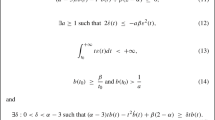Abstract
Let H be a real Hilbert space and Ф : H ↦ ℝ a twice continuously differentiable function, whose Hessian is Lipschitz continuous on bounded sets. We study the Newton-like second-order in time nonlinear dissipative dynamical system:\(\ddot x\left( t \right) + {\nabla ^2}\Phi \left( {x\left( t \right)} \right)\dot x\left( t \right) + \nabla \Phi \left( {x\left( t \right)} \right) = 0 \), plus Cauchy data, mainly in view of the unconstrained minimization of the function Ф.The main result is the gradient vanishing along any bounded trajectory as time goes to infinity. Results concerning the convergence of every bounded solution to a critical point are given in peculiar situations: when Ф is convex (with only one minimum) or is a Morse function.
Access this chapter
Tax calculation will be finalised at checkout
Purchases are for personal use only
Preview
Unable to display preview. Download preview PDF.
Similar content being viewed by others
References
F. Alvarez, On the minimizing property of a second order dissipative system in Hilbert space, preprint 98–05, Dépaгtement de Methémetiques, Université Montpellier II, to appear in SIAM J. of Control and Optimization.
F. Alvarez, J.M. Perez, Asymptotic analysis of evolution equations associated with Newton’s method for parametric approximations of convex minimization problems, Appl. Math. Optim. 38 (1998), 193–217.
H. Attouch and R. Cominetti, A dynamical approach to convex minimization coupling approximation with the steepest descent method, J. Differential Equations, 128 (2), (1996), 519–540.
H. Attouch, X. Goudou and P. Redont, The heavy ball with friction method: I the continuous dynamical system, preprint 1998/11, Département de Mathématiques, Université de Montpellier II; to appear in Communications in Contemporary Mathematics.
J.-P. Aubin, A. Cellina, Differential Inclusions, Springer, 1984.
J.-B. Baillon, Un exemple concernant le comportement asymptotique de la solution du prod èmedu/dt + дф(u) =0, Journal of Functional Analysis 28, 369–376 (1978).
J. F. Bonnans, J.-Ch. Gilbert, C. Lemaréchal, C. Sagastizábal, Méthodes Numériques d’optimisation, Springer, 1998.
H. Brézis, Opérateurs maximaux monotones, Mathematics Studies 5, NorthHolland-American Elsevier, 1973.
R.E. Bruck, Asymptotic convergence of nonlinear contraction seniigroups in Hilbert space, Journal of Functional Analysis, 18, (1975), 15–26.
A. Haraux, Systèmes dynamiques dissipatifs et applications, RMA 17, Masson, Paris, (1991).
H. Th. Jongen, A. Ruiz Jhones, Nonlinear optimization: on the min-max digraph and global smoothing, Calculus of variations and differential equations (Haifa, 1998), 119–135, Chapman&Hall/CRC Res. Notes Math., Chapman & Hall/CRC, Boca Raton, FL, 2000.
S. Lojasiewicz, Une propriété topologique des sous-ensembles analytiques réels. Colloques internationaux du C.N.R.S, n°117. Les Equations aux dérivées partielles (1963).
S. Lojasiewicz, Ensembles semi-analytiques, notes I.Н.E.S. (1965).
J. Palis and W. de Melo, Geometric theory of dynamical systems, Springer, 1982.
Author information
Authors and Affiliations
Editor information
Editors and Affiliations
Rights and permissions
Copyright information
© 2001 Springer-Verlag Berlin Heidelberg
About this paper
Cite this paper
Attouch, H., Redont, P. (2001). The Second-order in Time Continuous Newton Method. In: Lassonde, M. (eds) Approximation, Optimization and Mathematical Economics. Physica, Heidelberg. https://doi.org/10.1007/978-3-642-57592-1_2
Download citation
DOI: https://doi.org/10.1007/978-3-642-57592-1_2
Publisher Name: Physica, Heidelberg
Print ISBN: 978-3-7908-1363-0
Online ISBN: 978-3-642-57592-1
eBook Packages: Springer Book Archive




